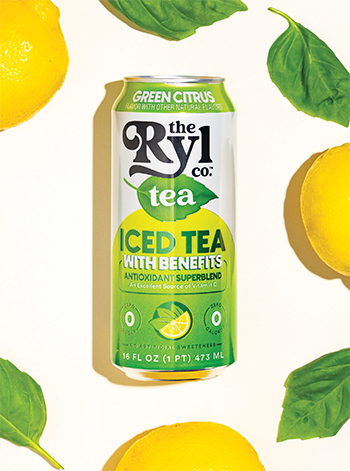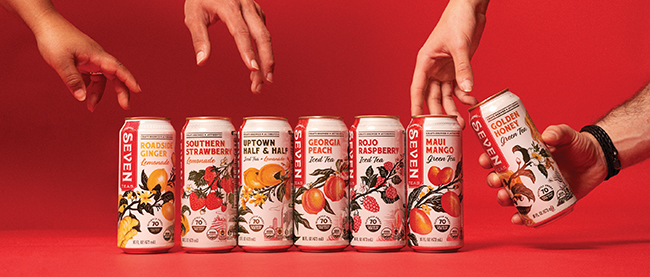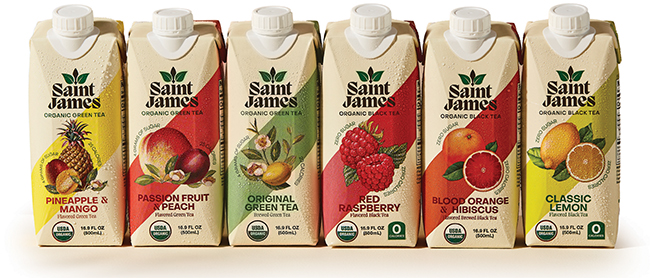How to Tea Up for Success: A Category Dive Gives a Blueprint for Insurgency
There are a few idioms that commonly circulate throughout the beverage industry.
Liquid to lips. Inch wide, mile deep. Getting hands on cans. Cold is sold.
No matter the category, these platitudes have long been trail markers as drink makers scale into the next stage of growth.
In iced tea, things are pretty entrenched: AriZona, Coke’s Gold Peak, and PepsiCo’s Pure Leaf have more than 50% of the volume.
Still, a number of iced tea brands have faith that if they follow the idioms, they’ll be able to build out from their emerging phase to an insurgent period. By taking a more granular approach to distribution coverage, leveraging social strategies to guide in-store merchandising, and emphasizing broader portfolios of format and pack sizes these beverage brands are breathing new life into an entrenched category.
It’s not like RTD iced tea (Liquid Death’s well-funded entry aside) is hip, but competing with the big boys has for years been more of an exercise in retail block-and-tackle than the push for brand recognition and a hefty social media following that seems to power newer categories. So insurgent tea brands need to focus resources on driving volume while continuing to open new retail accounts, finding original ways to reach consumers outside of the cold case, and to entice supermarkets and box stores to put multipacks on ambient shelves.
Just as campaign season requires a strong get-out-the-vote effort, tea brands tend to focus on the fundamentals as the first step in challenging iced tea high office incumbents. That means that a look at the strategies of insurgent candidates like Ryl, St. James, and Seven Teas gives a great blueprint of the expansion ground game.
Liquid To Lips
After debuting less than two years ago, Ryl Tea is moving to a holistic approach to scale up its whole operation — from production to marketing to identity — as it aims to be “different in the trade,” said founder and CEO Blodin Ukella.
Ukella, a youthful founder who has nevertheless racked up years of experience with brands like OWYN and Bai, said he has been inspired by what functional brands like Poppi or Celsius have done to reinvent tired categories and, in turn, brought incremental growth to their businesses.
“‘Ryl’ stands for ‘rethink your liquids,’” he said. “We’re not necessarily a tea company. We’re the next-gen consumer beverage platform.”
Those youthful consumers demand added value: not just soda or energy drinks, but claims of gut-health, hydration or an elevated metabolic reaction, said Ryl president Ken Kurtz, who joined the team at the beginning of the year.
For Kurtz, who previously helped spin Bai into a billion-dollar brand on the back of its antioxidant focus, the question is, “How do we rebuild the category in a different way with a different consumer?” adding, “When you look at the legacy brands in the ready-to-drink iced tea space, they’re kind of primitive in terms of their offerings to consumers.”
Hence Ryl’s tagline as “Iced tea with benefits.” Initially referencing its high polyphenol count, now its emphasis is on being a low sugar tea with the functional value of immunity and antioxidants.
New Jersey-based Halfday, which adds fiber to the mix, has also found a following, and strong distribution, under a functional framing. The brand has added new retail partners from Whole Foods to Wawa in the last year and is in over 3,000 doors across the country.
Having gained a marketing foothold through social platforms, Ryl Tea is in the process of developing a DSD presence that will allow the brand to have full national coverage by the end of the year, Kurtz said. It’s already made progress this year with Target and CVS to become a mainstay in the mass, convenience and drug store channels, but the team wants more shelves.
“We’re in a period of explosive growth and everything is moving at an extremely fast pace,” he said. “What we’re trying to do is make sure we maintain the disciplines and relationships that we have with existing customers as we continue to build out.”
Inch Wide, Mile Deep.
So what’s that kind of buildout like? Declan Duggan should know. With 20 years of sales experience working for NutraBolt, High Brew Coffee, Sweet Leaf Tea and Diageo Guinness USA, Duggan has repreatedly dealt with the sales challenge of knitting together a wide DSD network.
“You have to have a few beachhead accounts in each region, where you can really dig in and have your team and your distributors identify who your consumer is, where they shop and if you’re a good company for them,” he said.
For example, if an iced tea brand has been distributed to Whole Foods Market stores using UNFI, switching over to a DSD to service those accounts can become “convoluted and bumpy” with additional paperwork and possible out-of-stocks, he said. The last thing a brand wants to do in this stage of growth is poison the well with a retail buyer.
Done properly, a DSD can often bring a more hands-on approach to the brand–retailer relationship. In comparison, broadline distributors are negotiating sometimes hundreds of brands over multiple categories with less time to devote to each product.
That lack of attention in broadline distribution is the reason Saint James Iced Tea’s key initiative for 2024 is to build out an “intentional” DSD network, said CEO Brad Neumann .
In the first half of the year, L.A.-headquartered Saint James, which relies on distinctive Tetra Pak boxes, has signed on with five DSDs (Classic in SoCal, Savannah in the Carolinas, Columbia in the Pacific Northwest, Summit in Las Vegas and Manhattan Beer to service New York City) to fulfill that mission.
“I tell the team that we need at least 500 stores in a market if we’re going to go after a DSD,” he said. “If we sign a DSD, that means adding two or three people at a minimum to support the market. Also we need to make sure we’re hitting different channels within those markets.”
Growth requires expenditures, particularly new hires. Since December, Saint James has added 16 new positions – regional sales managers and reps help oversee the additional tracking, logistics, ordering and billing that comes with a DSD network.
One of those hires? Tom Kurtz, who came on as VP of sales and distribution (beverage family alert — that was around the same time his brother Ken took the president position at Ryl). Halfday has also invested in putting the right people in the right roles by appointing Sean Lynch as its president in February. Lynch was Liquid Death’s former chief sales officer.
Hands On Cans
Adding distribution is just part of the issue for brands, however, as it forces a brand to take a harder look at its in-store presence, from promos to merchandising.
When Saint James launched in 2022, it invested heavily in social media, with influencer campaigns and sponsored parties at live music festivals and cultural events. In the last year, however, the brand has shifted its focus to determine how it can utilize its brand recognition to drive people into stores.
For Stagecoach music festival this year, the company built custom off-shelf displays to put in over 500 stores on the West Coast to promote the event and offer free tickets via a branded sweepstakes. The campaign yielded a 350% lift at retail, Neumann said.
“We took that case study to our buyers at additional banners and additional chains and said: This is the impact we can bring to your store. Let’s figure out how we’re going to plug into the calendar,” he said.
This intentional approach to driving volumes by pairing retail partners with the brand’s core consumers has allowed it to grow exponentially. Saint James reported $500,000 in revenue in 2022 and in 2023 (its first full year) it had hit $2.1 million. Year-to-date in 2024, it has already doubled its 2023 sales.
While herding customers to new retail doors, Saint James has found a need for more support in merchandising. Pheasant Creek Retail Services is the iced tea maker’s boots on the ground in places where Saint James doesn’t have as much DSD coverage.
“We’re your eyes and ears,” said Gina Pfister, managing partner at Pheasant Creek. “We’re not just going out and checking your product. We’re talking to the store manager, talking about your brand and checking in with the receiver, because everybody knows the receiver really is the true store manager.”
The partnership has allowed Saint James to better understand the sales data it receives from its retail partners and to adapt new strategies to meet the needs of each store or region.
This goes back to the “know your business, know your customer” strategy that Duggan has taken in his approach to building tangible sales growth.
“When you walk into a Target versus a Walmart you need to be talking the language of the manager,” Duggan said. “How do they speak about their products? What motivates them? How are they paid? Find out.”
Learning the terminology of different retailers and the nuances of working in different regions comes with experience, but it can mean the difference between being on the bottom of a shelf and getting an endcap or off-shelf display. All of which translate into units sold per store, Duggan said.
Cold Is Sold.
Early stage beverage brands know that the best place to drive trial is by getting placement in the grab-and-go cold case. But multipacks are the key in volume-focused channels like conventional grocery chains and mass retailers like Target, Walmart or Costco.
Los Angeles-based Seven Teas started its journey in 2017 as a premium-positioned glass bottle iced tea brand. In the last year, however, it launched a line of 16 oz. canned drinks to open new, conventional grocery chains.
In glass, the brand found a sweet spot with conventional buyers in the “better-for-you” beverage coolers often located in the produce section of the store. It’s a place where consumers are more likely to pick up a bottle of cold-pressed juice or kombucha, so it fits from a pricing standpoint.
“There’s not as much sticker shock there,” said Seven Teas co-founder Jeremy Issakharian.
But that success has led the brand to strategize about how it can move deeper into conventional with an eye towards a presence in mass and club stores.
This all means getting cans into multipacks, a strategy that’s also being embraced by Saint James and Ryl.
The challenge is getting the “price-pack architecture” right because a 12-pack of organic iced tea for $25 is a hard sell, Issakharian said, especially when AriZona can go for below $10 in many retailers. But supermarket shoppers are “pantry loaders” – they aren’t just seeking single-serves.
From a pricing standpoint, “it’s almost like if you can’t beat them, join them,” Issakharian said. “Otherwise you risk being lost on-shelf.”
So Seven Teas is looking at a variety of solutions, like 4-, 6- or 8-packs, as well as smaller can sizes, to compete outside of the refrigerated case. In essence, it is prioritizing volume over margin.
Ideally, Seven Teas would like to be both in the produce section’s cold-case, where it can continue to drive immediate trial, while also developing a brand block of its multipacks in ambient.
The payoff? Mass retailers like Walmart are continuing to add more organic products to their shelves, and Seven Teas sees its USDA Organic label as an advantage over AriZona, Pure Leaf and Gold Peak.
“People are going into these markets looking for that little green badge,” he said. “All the main category contenders are not organic, so organic and low sugar are the two things that stand out and that’s why we stress those on the front of our label.”


Receive your free magazine!
Join thousands of other food and beverage professionals who utilize BevNET Magazine to stay up-to-date on current trends and news within the food and beverage world.
Receive your free copy of the magazine 6x per year in digital or print and utilize insights on consumer behavior, brand growth, category volume, and trend forecasting.
Subscribe


